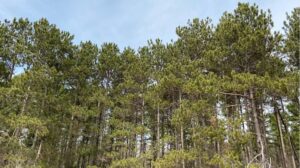
A stand of red pine trees towers over its Wisconsin stand. / Photo Credit: Wisconsin DNR
By Ryan Heiderman, DNR Forest Inventory Analyst
Ryan.Heiderman@wisconsin.gov
Of Wisconsin’s almost 17 million acres of forest land, the red pine forest type currently covers approximately 815,000 acres. Of those red pine acres, 80%, or 656,000 acres, are planted.
Overall, the acres of red pine have increased substantially since the cutover period of the early 1900s (Figure 1), particularly from planted red pine. In the 1939 report summarizing Wisconsin’s first periodic forest inventory, the authors give a dire warning stating that, with the exception of jack pine, the pine forests are almost gone, having been depleted and deforested in the decades prior.
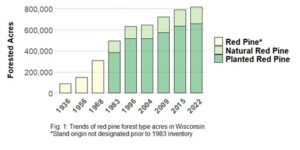
Chart showing trends of red pine forest type acres in Wisconsin. The asterisk indicates that stand origin was not designated prior to the 1983 inventory. / Graphic Credit: Ryan Heiderman, Wisconsin DNR
This early inventory indicated much of the deforested sandy pine forest had become occupied by aspen, paper birch and scrub oak. They went on to say while natural regeneration might be expected eventually, indications were that it would be slow, and planting seemed to be the only recourse if early reforestation was to be accomplished.
Reporting on the next periodic inventory in 1956, the authors highlighted that red pine acres were ‘coming back’ and white pine acres fading. They reported that much of the tree planting that had been done since the previous inventory was mostly red pine. Echoing the advice from the earlier inventory report, the authors again stated the importance of forest planting – saying reforestation could increase the acreage of productive forest land, but the planting job was a big one. At the time, they reported some 148,000 acres of the red pine forest type. They reported that over half (53%) of these red pine acres were on public lands. Today, more than 60% of red pine acres are in privately-owned forests.
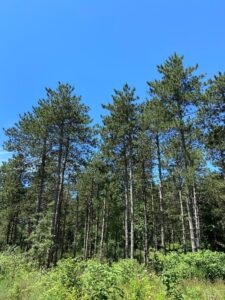
A stand of tall red pine trees in Wisconsin. / Photo Credit: Wisconsin DNR
Data from the next periodic inventory of Wisconsin’s forests in 1968 showed a more than doubling of red pine acres since the 1956 inventory, increasing further to 310,000 acres. The 1983 periodic inventory showed there was some 495,000 acres of red pine, with 78%, or 383,000 acres, as plantation. Red pine acres have more than doubled between the 1983 and 2022 inventories, with the majority (85%) of this increase from planted red pine.
Like much of Wisconsin’s forests, the red pine forest type is aging, and volume is moving into large size classes. The 1956 report states that the majority (64%) of red pine acres were in seedling or sapling size-classes. Conversely, today only 5% of red pine acres are in the smallest size classes, with most acres falling in the large diameter size class.
The 2022 inventory found 62% and 87% of planted and natural acres of red pine respectively are in the largest diameter size class. The average age of red pine plantations in 1983 was 28 years whereas today the average age is 44 years.
The economic rotation length of red pine is between 51 and 80 years. About 36% of planted red pine already meets this rotation length, with many more acres set to enter this phase over the next decade.
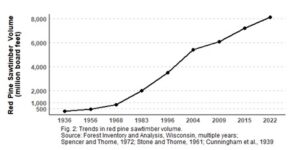
Figure 2: Trends in red pine sawtimber volume in Wisconsin. Source: Forest Inventory and Analysis, Wisconsin, multiple years. / Graphic Credit: Ryan Heiderman, Wisconsin DNR
The latest inventory from 2022 showed 2.4 billion cubic feet of merchantable volume, a substantial increase from the 775 million found in the 1983 inventory. Red pine was the sixth-most plentiful species in sawtimber volume in 1983. The 2022 inventory showed approximately 8.1 billion board feet of sawtimber volume (Figure 2), moving red pine up to the third-most plentiful.
Volume is shifting into larger diameter classes as these red pine stands age (Figure 3). Utilization of red pine depends on merchandising and product specifications of mills and other users of red pine logs. Balancing growth, removals and age class diversification will be important for management of red pine stands in Wisconsin over the coming decades.
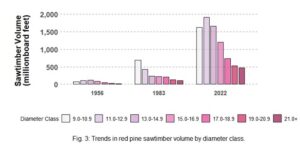
Figure 3: Trends in red pine sawtimber volume by diameter class. / Graphic Credit: Ryan Heiderman, Wisconsin DNR
Currently, red pine annual net volume growth is 2.4 times the amount of volume removed (Figure 4). This growth-to-removal ratio is a measure of sustainability and indicates there is a strong red pine timber supply while also maintaining the ecological, environmental and recreational values of Wisconsin forests.

Figure 4: Roundwood production for the top species in Wisconsin, by volume. / Graphic Credit: Ryan Heiderman, Wisconsin DNR
Red pine is the most utilized species in Wisconsin for forest products (Figure 5). In 2019, red pine accounted for 16% of overall production, including 22% of all roundwood growing stock utilized by Wisconsin mills, with most of this volume (36%) going to saw logs.
In the absence of low severity fires, which had historically perpetuated red pine stands in Wisconsin, natural regeneration has been a challenge. As was the case almost 100 years ago, the success of red pine is in part dependent on replanting efforts which will play a large role in the future success of the red pine forest type across Wisconsin.
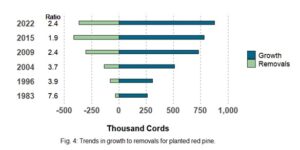
Figure 5: Trends in growth as compared to removals for planted red pine in Wisconsin. / Graphic Credit: Ryan Heiderman, Wisconsin DNR
